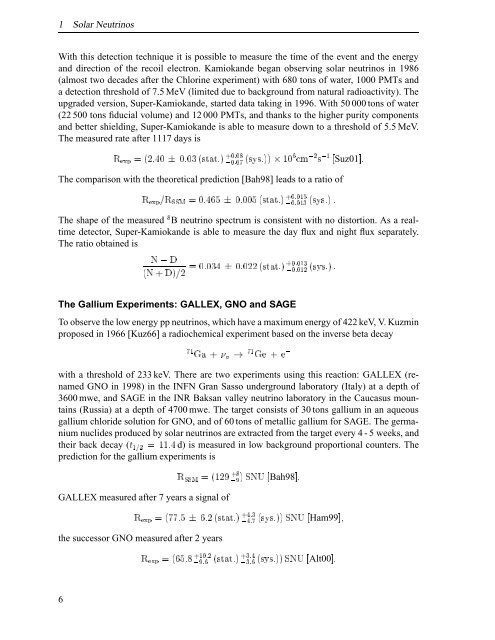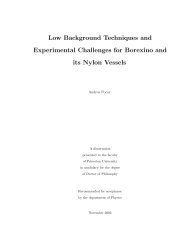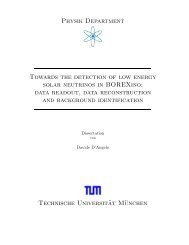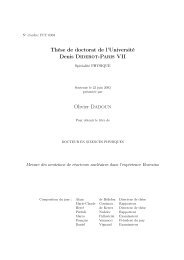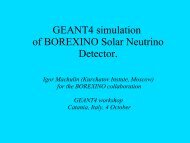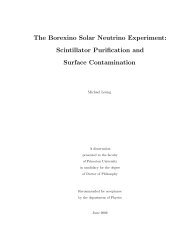Development of a Liquid Scintillator and of Data ... - Borexino - Infn
Development of a Liquid Scintillator and of Data ... - Borexino - Infn
Development of a Liquid Scintillator and of Data ... - Borexino - Infn
Create successful ePaper yourself
Turn your PDF publications into a flip-book with our unique Google optimized e-Paper software.
1 Solar Neutrinos<br />
With this detection technique it is possible to measure the time <strong>of</strong> the event <strong>and</strong> the energy<br />
<strong>and</strong> direction <strong>of</strong> the recoil electron. Kamiok<strong>and</strong>e began observing solar neutrinos in 1986<br />
(almost two decades after the Chlorine experiment) with 680 tons <strong>of</strong> water, 1000 PMTs <strong>and</strong><br />
a detection threshold <strong>of</strong> 7.5 MeV (limited due to background from natural radioactivity). The<br />
upgraded version, Super-Kamiok<strong>and</strong>e, started data taking in 1996. With 50 000 tons <strong>of</strong> water<br />
(22 500 tons fiducial volume) <strong>and</strong> 12 000 PMTs, <strong>and</strong> thanks to the higher purity components<br />
<strong>and</strong> better shielding, Super-Kamiok<strong>and</strong>e is able to measure down to a threshold <strong>of</strong> 5.5 MeV.<br />
The measured rate after 1117 days is<br />
ÊÜÔ ¦ ×ØØ<br />
<br />
×Ý× ¢ Ñ<br />
The comparison with the theoretical prediction [Bah98] leads to a ratio <strong>of</strong><br />
ÊÜÔÊËËÅ ¦ ×ØØ<br />
×<br />
<br />
×Ý× <br />
Suz01℄<br />
The shape <strong>of</strong> the measured B neutrino spectrum is consistent with no distortion. As a realtime<br />
detector, Super-Kamiok<strong>and</strong>e is able to measure the day flux <strong>and</strong> night flux separately.<br />
The ratio obtained is<br />
Æ <br />
Æ <br />
¦ ×ØØ<br />
The Gallium Experiments: GALLEX, GNO <strong>and</strong> SAGE<br />
<br />
×Ý× <br />
To observe the low energy pp neutrinos, which have a maximum energy <strong>of</strong> 422 keV, V. Kuzmin<br />
proposed in 1966 [Kuz66] a radiochemical experiment based on the inverse beta decay<br />
<br />
with a threshold <strong>of</strong> 233 keV. There are two experiments using this reaction: GALLEX (renamed<br />
GNO in 1998) in the INFN Gran Sasso underground laboratory (Italy) at a depth <strong>of</strong><br />
3600 mwe, <strong>and</strong> SAGE in the INR Baksan valley neutrino laboratory in the Caucasus mountains<br />
(Russia) at a depth <strong>of</strong> 4700 mwe. The target consists <strong>of</strong> 30 tons gallium in an aqueous<br />
gallium chloride solution for GNO, <strong>and</strong> <strong>of</strong> 60 tons <strong>of</strong> metallic gallium for SAGE. The germanium<br />
nuclides produced by solar neutrinos are extracted from the target every 4 - 5 weeks, <strong>and</strong><br />
their back decay (Ø d) is measured in low background proportional counters. The<br />
prediction for the gallium experiments is<br />
GALLEX measured after 7 years a signal <strong>of</strong><br />
ÊËËÅ <br />
ËÆÍ Bah98℄<br />
ÊÜÔ ¦ ×ØØ<br />
the successor GNO measured after 2 years<br />
6<br />
ÊÜÔ <br />
<br />
×ØØ<br />
<br />
×Ý× ËÆÍ Ham99℄<br />
<br />
×Ý× ËÆÍ Alt00℄


